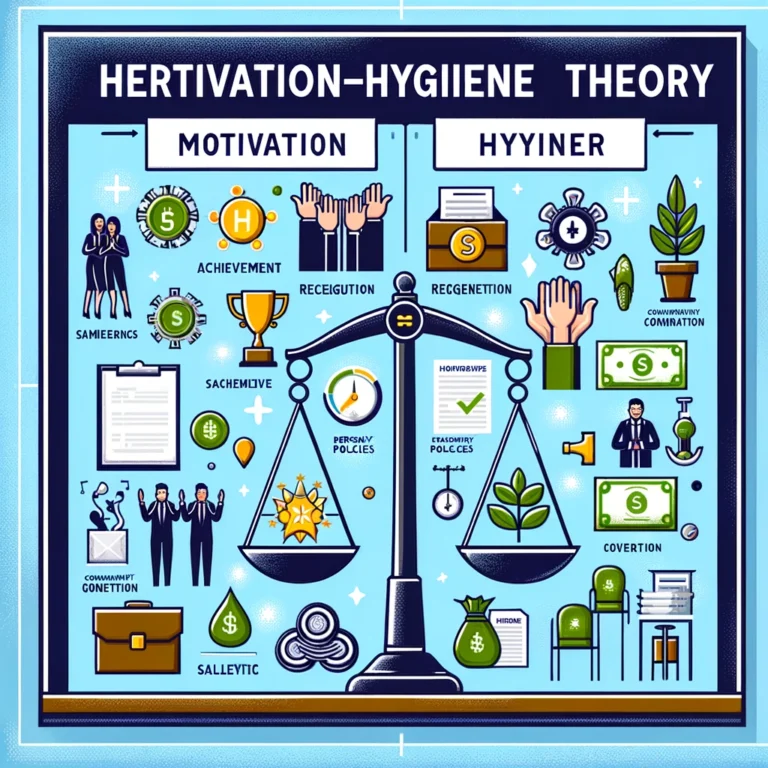Frederick Herzberg’s Motivation-Hygiene Theory, also known as the Two-Factor Theory, revolutionized the understanding of workplace motivation during the late 1950s. This theory proposes that two sets of factors influence employee satisfaction and motivation: motivators (or satisfaction factors) and hygiene factors (or dissatisfaction factors). Herzberg’s research suggested that the factors leading to job satisfaction are separate and distinct from those that lead to job dissatisfaction. This comprehensive analysis explores Herzberg’s theory in depth, examining its components, implications for management, and practical applications, highlighted through an industry example relevant to IB Business & Management studies.
Herzberg’s Two-Factor Theory Explained
Motivators (Satisfaction Factors): These factors are intrinsic to the job and can lead to high levels of motivation and job satisfaction. They are related to the content of the work itself. Motivators include:
- Achievement
- Recognition
- Work itself
- Responsibility
- Advancement
- Growth
Hygiene Factors (Dissatisfaction Factors): These factors are extrinsic to the job and, while their presence might not significantly motivate employees or lead to satisfaction, their absence can cause dissatisfaction. Hygiene factors are related to the work environment or context in which the job is performed. They include:
- Company policies
- Supervision
- Relationship with supervisor and peers
- Work conditions
- Salary
- Security
Implications for Management
Herzberg’s theory implies that simply removing dissatisfaction factors (hygiene) is not enough to motivate employees. To truly enhance motivation and job satisfaction, management must also focus on improving motivators. This dual approach requires managers to ensure that hygiene factors are adequately addressed to avoid employee dissatisfaction and to actively integrate motivators into job design and organizational culture.
Practical Applications
Enhancing Motivators:
- Job Enrichment: Designing jobs that include a greater variety of work content, providing meaningful tasks, and offering more autonomy and responsibility to employees.
- Recognition Programs: Implementing formal and informal ways to recognize employee achievements and contributions.
- Career Development: Providing opportunities for advancement and professional growth through training, mentoring, and clear career paths.
Addressing Hygiene Factors:
- Improving Work Conditions: Ensuring a safe, comfortable, and aesthetically pleasing work environment.
- Reviewing Compensation Packages: Offering competitive salaries and benefits to meet or exceed industry standards.
- Transparent Communication: Developing clear company policies and ensuring they are communicated effectively, along with fostering open lines of communication between employees and management.
Industry Example: Tech Startups
In the dynamic environment of tech startups, employee motivation and satisfaction are crucial for innovation and growth. Consider “InnovateTech,” a fictional tech startup that has recently implemented changes based on Herzberg’s theory.
- Motivators: InnovateTech introduced a program for recognizing innovative ideas, where employees can pitch new tech solutions. Successful pitches lead to project leadership roles, directly contributing to career advancement and offering significant work achievement.
- Hygiene Factors: The company reviewed its salary scales to ensure competitiveness within the tech industry. Additionally, it revamped its office layout to create more collaborative spaces, addressing work conditions, and established a more flexible policy regarding remote work to accommodate employees’ needs for autonomy.
Advantages
- Job enrichment.
- Makes clear for the business what needs to be done in order to remove dissatisfaction and improve motivation.
Disadvantages
- Job enrichment may be expensive and difficult to organise.
- Workers may get used to improved pay/conditions and take these things for granted.
- Does not apply to all occupations such as low skilled/ paid jobs.
- Research sample included only high skilled workers, therefore findings don’t necessarily apply.
- Not all employees want extra responsibility or stress.
Conclusion
Herzberg’s Motivation-Hygiene Theory offers valuable insights into the complexities of employee motivation and satisfaction. By distinguishing between motivators and hygiene factors, it provides a nuanced framework for understanding what drives employee behavior and how organizations can cultivate a motivated workforce. The example of InnovateTech illustrates how adopting Herzberg’s principles can lead to practical strategies for enhancing employee satisfaction and motivation in the workplace. For IB Business & Management students, grasping the implications of this theory is essential for developing effective human resource management practices that can significantly impact organizational success.






